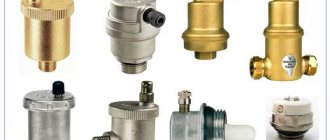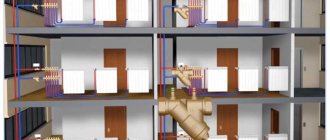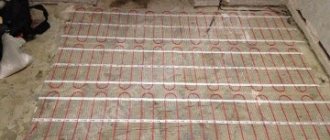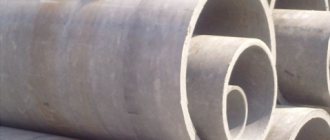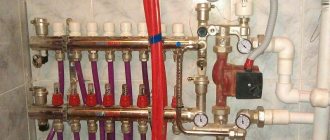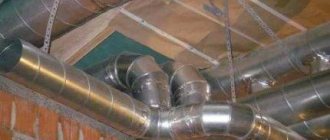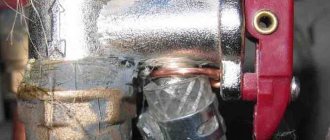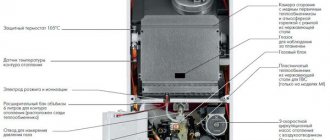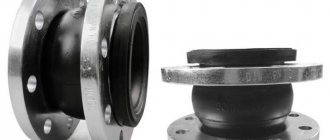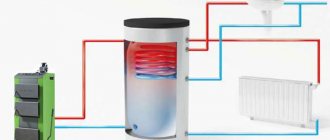General information
Single-stage axial fans Axipal FTDA, axial roof fans with a diffuser FTDA-RD and axial roof fans with a valve FTDA-RB (hereinafter referred to as FTDA fans) are designed to move air and other gases, the aggressiveness of which in relation to carbon steels of ordinary quality is not higher than the aggressiveness of air, containing dust no more than 10 mg/m3. Single-stage axial fans Axipal FTDE, axial roof fans with a diffuser FTDE-RD and roof fans with a valve FTDE-RB (hereinafter referred to as FTDE fans) are designed to move explosive gas-vapour-air mixtures of categories IIA, IIB and IIC, groups T1, T2, T3 and T4 according to GOST R classification 51330.0-99, materials and coatings of the flow part of fans that do not cause accelerated corrosion and do not contain explosives, additional oxygen, explosive dust, sticky and fibrous materials, as well as iron oxides. The fans are designed to serve explosive zones of premises of classes 1 and 2 according to GOST R 51330.13-99. The temperature of the transported medium is from -40 °C to +40 °C. Fans FTDA and FTDE are intended for operation in conditions of a macroclimatic region with a temperate climate (version U), placement categories 1, 2, 3 and 4 according to GOST 15150-69. At the customer's request, FTDA fans can have a different climatic design, and can also be designed for operation at temperatures up to + 90 °C. FTDE fans are intended for servicing explosive zones of premises of classes V-1a, V-1b, V-1g according to the classification of “Electrical Installation Rules” (PUE). The fans are equipped with asynchronous electric motors with a rotation axis height from 56 to 200 mm. Fans can be mounted directly in air ducts in both horizontal and vertical sections.
An example of selecting fans for a ventilation system
Home / ARTICLES / An example of selecting fans for a ventilation systemThe resistance to the passage of air in a ventilation system is mainly determined by the speed of air movement in this system. As speed increases, resistance also increases. This phenomenon is called pressure loss. The static pressure created by the fan causes air movement in the ventilation system, which has a certain resistance. The higher the resistance of such a system, the lower the air flow moved by the fan. Calculation of friction losses for air in air ducts, as well as the resistance of network equipment (filter, silencer, heater, valve, etc.) can be made using the corresponding tables and diagrams indicated in the catalog. The total pressure drop can be calculated by summing the resistance values of all elements of the ventilation system.
Recommended air speed in air ducts:
| Main air ducts | 6,0-8,0 |
| Side branches | 4,0-5,0 |
| Distribution ducts | 1,5-2,0 |
| Supply grilles near the ceiling | 1,0-3,0 |
| Exhaust grilles | 1,5-3,0 |
Determination of air speed in air ducts:
V= L / 3600*F (m/sec)
where L is air flow, m3/h; F—channel cross-sectional area, m2.
Recommendation 1.
Pressure loss in a duct system can be reduced by increasing the cross-section of the ducts to ensure relatively uniform air velocity throughout the system. In the image we see how it is possible to ensure relatively uniform air speeds in a duct network with minimal pressure loss.
Recommendation 2.
In systems with a long length of air ducts and a large number of ventilation grilles, it is advisable to place the fan in the middle of the ventilation system. This solution has several advantages. On the one hand, pressure losses are reduced, and on the other hand, air ducts of a smaller cross-section can be used.
Example of calculation of a ventilation system:
The calculation must begin by drawing up a sketch of the system indicating the locations of air ducts, ventilation grilles, fans, as well as the lengths of the air duct sections between the tees, then determine the air flow in each section of the network.
Let's find out the pressure loss for sections 1-6, using the graph of pressure loss in round air ducts, determine the required diameters of the air ducts and the pressure loss in them, provided that it is necessary to ensure the permissible air speed.
Section 1: air flow will be 220 m3/h. We assume the diameter of the air duct is 200 mm, the speed is 1.95 m/s, the pressure loss is 0.2 Pa/m x 15 m = 3 Pa (see the diagram for determining pressure loss in air ducts).
Section 2: let’s repeat the same calculations, not forgetting that the air flow through this section will already be 220+350=570 m3/h. We take the diameter of the air duct to be 250 mm, the speed to be 3.23 m/s. The pressure loss will be 0.9 Pa/m x 20 m = 18 Pa.
Section 3: air flow through this section will be 1070 m3/h. We take the diameter of the air duct equal to 315 mm, the speed is 3.82 m/s. The pressure loss will be 1.1 Pa/m x 20= 22 Pa.
Section 4: air flow through this section will be 1570 m3/h. We assume the diameter of the air duct is 315 mm, the speed is 5.6 m/s. The pressure loss will be 2.3 Pa x 20 = 46 Pa.
Section 5: air flow through this section will be 1570 m3/h. We take the diameter of the air duct equal to 315 mm, speed 5.6 m/s. The pressure loss will be 2.3 Pa/m x 1= 2.3 Pa.
Section 6: air flow through this section will be 1570 m3/h. We take the diameter of the air duct equal to 315 mm, speed 5.6 m/s. The pressure loss will be 2.3 Pa x 10 = 23 Pa. The total pressure loss in the air ducts will be 114.3 Pa.
When the calculation of the last section is completed, it is necessary to determine the pressure loss in the network elements: in the CP 315/900 silencer (16 Pa) and in the KOM 315 check valve (22 Pa). We will also determine the pressure loss in the taps to the grilles (the total resistance of 4 taps will be 8 Pa).
Determination of pressure loss at bends of air ducts
The graph allows you to determine the pressure loss in the outlet based on the bend angle, diameter and air flow.
Example. Let us determine the pressure loss for a 90° outlet with a diameter of 250 mm at an air flow of 500 m3/h. To do this, we find the intersection of the vertical line corresponding to our air flow with an inclined line characterizing the diameter of 250 mm, and on the vertical line on the left for a 90° outlet we find the value of pressure loss, which is 2 Pa.
We accept for installation ceiling diffusers of the PF series, the resistance of which, according to the schedule, will be 26 Pa.
Now let’s sum up all the pressure loss values for straight sections of air ducts, network elements, bends and grilles. The desired value is 186.3 Pa.
We calculated the system and determined that we need a fan that removes 1570 m3/h of air with a network resistance of 186.3 Pa. Taking into account the characteristics required for the operation of the system, we will be satisfied with the fan; the characteristics required for the operation of the system will suit us with the VENTS VKMS 315 fan.
Determination of pressure losses in air ducts.
Determination of pressure loss in a check valve.
Selection of the required fan.
Determination of pressure loss in silencers.
Determination of pressure losses at bends of air ducts.
Determination of pressure loss in diffusers.
source -https://www.vents
For questions regarding calculation, selection, installation of ventilation and air conditioning systems, call tel. in Surgut 45-71-21
On the chart
Individual graph of Axipal fan characteristics
1 capacity Q, m3/hour 2 total pressure Pv, Pa 3 solid blue lines show the fan performance curves depending on the angle of installation of the impeller blades with an accuracy of one degree 4 the blue dotted line shows the dynamic pressure without a diffuser 5 the blue dotted line shows the dynamic pressure with diffuser 6 impeller blade angle 7 maximum impeller blade angle 8 solid green lines show fan power consumption curves, kW 9 green dotted lines show average sound pressure levels, dB(A)
The selection of a fan begins with determining its number (size) and synchronous rotation speed. Based on the given aerodynamic characteristics (performance Q and total pressure Pv), the size (number) of the fan and the synchronous rotation speed of the fan impeller are determined on the summary graphs. This may take into account the optimal size of air ducts or openings in walls or ceilings. On the corresponding individual characteristics graph, at the point of intersection of the coordinates of productivity and total pressure (operating point), the fan characteristics curve is found for the corresponding angle of installation of the impeller blades. These curves are drawn with an interval of setting the blade angle of one degree. The operating point simultaneously shows the power consumed by the fan (if the operating point and the power consumption curve do not coincide, interpolation must be carried out) and the average sound pressure level. Dynamic pressure and dynamic pressure with an attached diffuser are found at the intersection of the corresponding inclined straight lines with a vertical line drawn from the capacity Q (values are read on the total pressure scale Pv). Upon customer request, Axipal fans can be equipped with electric motors of both domestic and foreign origin. If the actual operating parameters of the fan (temperature, humidity, absolute atmospheric pressure, air density or actual rotation speed of the electric motor) differ from the parameters at which the aerodynamic characteristics graphs were drawn up, the actual aerodynamic characteristics of the fan and power consumption should be clarified using the following formulas (GOST 10616- 90) and the basic laws of ventilation: Q=Q0•n/n0 (1)
Pv = Pv0 • (n/n0 )2 (2)
N=N0•(n/n0)3 , (3)
where Q is the actual productivity, m3/hour or m3/s;
Pv – actual total pressure, Pa; N – actual power consumption, kW;
n – actual electric motor speed, rpm;
Q0 – productivity taken from the graph, m3/hour or m3/s;
Pv0 – total pressure taken from the graph, Pa;
N0 – power consumption taken from the graph, kW;
n0 – electric motor speed taken from the graph, rpm. When operating fans at temperatures exceeding 40 °C, it should be borne in mind that for every 10 °C increase in temperature, the power consumption of the electric motor is reduced by 10%. Thus, at a temperature of +90 °C, the required electric motor power should be twice as large as that found from the aerodynamic characteristics graphs. The heat resistance class of the electric motor insulation must be at least class “F”.
Example of fan selection
IT IS REQUIRED TO SELECT a fan for the following air network parameters: GIVEN:
- productivity Q = 8280 m3/hour
- total pressure Pv =130 Pa
- temperature of transported air t = 20 °C
- density of transported air ρ = 1.2 kg/m
SOLUTION:
- Using summary graphs of aerodynamic characteristics for given values of performance and total pressure, we select the optimal fan size and synchronous rotation speed from options that satisfy the selection conditions. This is the FTDA-050 fan, equipped with an electric motor with a synchronous rotation speed n0 = 1450 rpm at a power supply frequency of 50 Hz.
- On the graph of the individual characteristics of the FTDA-050 fan with an impeller rotation speed n0 = 1450 rpm (an impeller with four blades, for example), we mark the fan operating point, which lies at the intersection of the coordinates Q0 = 8280 m3/hour and Pv0 = 130 Pa. Determine the installation angle of the impeller blades. It is equal to 250. After interpolation, we obtain the value of power consumption N0 = 0.46 kW. According to the section “Equipping with electric motors” of this manual, the possibility of equipping this fan with an electric motor with a power of N = 0.55 kW and a rotation speed of n = 1500 rpm is determined. For installation according to the “Reference Data” section, an AIS 80A4 electric motor with a power of N = 0.55 kW and an actual rotation speed of n = 1360 rpm is selected.
- The actual aerodynamic parameters of the fan and power consumption, specified by formulas (1, 2 and 3), will be as follows: Q = 8280 • (1360/1450) = 7766 m3/hour; 32 P =130•(1360/1450) =114.4 Pa; v N = 0.46 • (1360/1450)3 = 0.38 kW.
- Since the actual rotation speed of the electric motor differs significantly from the rotation speed of the fan impeller for which the graphs are drawn, it is necessary to recalculate the fan characteristics from the required values to those that need to be plotted on the graph. Using formulas (1 and 2) and transforming the expressions regarding the values with index “0”, we obtain: Q0 = 8280 • (1450/1360) = 8828 m3/hour; Pv0 = 130 • (1450/1360)2 = 148 Pa. We find and mark the conditional operating point on the same graph. We determine the angle of installation of the blades: 280. Power consumption according to the schedule: N0 = 0.55 kW. We find the actual power consumption using formula (3):
- Designation of the selected fan: FTDA-050-4-28 with an AIS 80A4 electric motor with a power of N = 0.55 kW and a rotation speed of n = 1360 rpm.
- Based on the figure and table, we determine the overall and connecting dimensions of the fan.
N = 0.55 • (1360/1450)3 = 0.45 kW.
Selection of radial fan
VEZA fan selection program VezaFan
In this article, you will learn how to select a fan. Let’s assume that you need to select a radial fan of version 1 to move air with parameters close to standard ones. The design ventilation capacity is 33,000 m3/h with an aerodynamic resistance of the ventilation system P = 1300 Pa.
We will select a fan based on performance and pressure. Fans of type VR-80-70 correspond to the specified design parameters. According to the technical characteristics, we preliminarily establish that the initial fan selection data corresponds to fans number 10, having a speed of n = 980 rpm. operating range of parameters: productivity – V = 20500-39500 m3/h, total pressure – 1150-1450 Pa.
Using the individual aerodynamic characteristics of the VR-80-70-10.2-02 fan, we find the fan operating point (point A) and the corresponding parameters:
Fan capacity VR-80-70 — 33000 m3/h
The total pressure of the VR-80-70 fan is 1300 Pa
The speed of the fan wheel VR-80-70 is 980 rpm.
Fan efficiency VR-80-70 — 0.81
The maximum efficiency of the VR-80-70 fan is 0.82
Installed power of the VR-80-70 fan electric motor is 18 kW
We check the fulfilled conditions for selecting a fan:
n>= 0.9* n MAX
n B = 0.81>=0.9*0.82=0.738
Required power on the electric motor shaft, kW
N = (33000*1300)/(3600*1020* nV * nP ) = 14.4 kW
Installed power of the electric motor, kW with a short circuit safety factor = 1.1 (table)
Ny = K W * N = 1.1*14.4 = 15.9 kW
The installed power of the component electric motor is N y = 18.5 W.
Power reserve factor
| shaft power , kW | Power reserve factor, short circuit | |
| Radial fans | Axial fans | |
| <0,5 | 1,5 | 1,2 |
| 0,51-1 | 1,3 | 1,15 |
| 1,01-2 | 1,2 | 1,1 |
| 2,01-5 | 1,15 | 1,05 |
| >5 | 1,1 | 1,05 |
You can buy the fan using this blue link.
This is an example of selecting a radial fan and now you know how to select a radial fan. If you need to select a fan from a specific manufacturer or are worried that you have chosen the wrong one, then the VEZA fan selection program is quite suitable. The manufacturer VEZA has a fan selection program VezaFan or a Veza Kanal program, which can be easily downloaded from the Internet, or you can fill out a questionnaire for the design and manufacture of a fan.
Computer program for selecting VEZA fans
Basic laws of ventilation
- 1. Changing the rotation speed at a constant impeller diameter
- Air consumption depends on the rotation speed in direct proportion.
- Pressure is proportional to the square of rotational speed.
- Power is proportional to the rotational speed cubed.
- Changing the fan diameter (only for geometrically similar fans) at constant speed
- Air flow is proportional to the cubed diameter of the impeller.
- The pressure is proportional to the square of the impeller diameter.
- Power is proportional to the fifth power of the impeller diameter.
- Change in air density at a constant speed and constant diameter of the impeller
- Pressure is proportional to air density.
- Power is proportional to air density.
- Dynamic pressure where ρ – air density, kg/m3, V – air flow, m3/s.
- Total pressure
- Fan shaft power
Determination of noise characteristics
The sound pressure levels of the presented fans are determined by testing in accordance with the French standard NF S 31-021. This standard defines A-scale sound power levels. To do this, first use a sound level meter to measure the A-scale sound pressure level Lp and its octave components at 3 points on a hemispherical surface in accordance with the attached sketch.
These measurements are made in a testing laboratory on a fan built into a short duct system. The sound power level Lw is calculated using the following formula: Lw = Lp + 10 log 2 πrs2, where rs is the radius of the hemispherical surface on which measurements are made according to the above standard. The value of 10 log 2 πrs2 depends on the fan size and is given in the table.
The total value of the sound pressure level at 3 measured points 3, 5 and 6 is given in the fan characteristics given in the manual. To accurately calculate fan noise attenuation in a duct system, it is necessary to have sound power levels in octave frequency bands, also determined by the A scale. These octave levels can be determined by adding the corrections from Table 9 to the total sound power level. The same table can be used to determine the octave bands. sound pressure levels by adding appropriate corrections to the total sound pressure level. The indicated general sound power and pressure levels are given with an accuracy of 3 dB, and octave levels with an accuracy of 5 dB. It must be remembered that the sound power level for a given specific noise source is an objective physical quantity, while the sound pressure level depends largely on the characteristics of the surrounding surfaces, their type, shape and size.
How to choose the right fan?
Ventilation plays a huge role in baths, saunas, homes and businesses. The comfort of people staying in it and the service life of the wood from which it is made directly depend on it. A specialist in this field will help you select the correct fans for ventilation systems, but if you still want to figure out the issue yourself, then first of all you need to pay attention to the type of ventilation system. Supply and exhaust ventilation is especially popular due to its main advantages - reliability, quality and availability. Of course, if you turn to professional designers for help, they will select the right equipment, but if it fails or you want to build a bathhouse yourself, then you need to know what criteria are used to select a fan for a given ventilation system. Simple calculations
The two main factors when choosing a fan are its constant flow rate, as well as the amount of pressure loss of the ventilation system.
Air flow is determined by a formula for which you will need to know the cross-section of the largest air duct - the collector; for round ones you must measure the diameter, and for rectangular ones - the lengths of two sides. And the maximum permissible rate of air movement through the air duct is 6 m/s. Using existing formulas, determine one of the parameters for the correct selection of a fan. The loss of pressure in the ventilation system at a similar speed of air flow in the air duct is calculated on the basis that there is 3-6 Pa pressure for every meter of pipe.
Once you know these parameters, you can go shopping for the fan you need. Fan types
Since most often the air duct has a diameter of about ten centimeters, duct fans are selected for it. They are designed to transport and increase the speed of air flow inside the ventilation duct; it is mounted directly into the air duct.
Supply ventilation systems are equipped with the necessary fans according to the same principle. Supply ventilation specializes in supplying cold air from the outside, and without it it is impossible to imagine the normal operation of the steam room. However, when installing this type of ventilation, it is important to take care of an exhaust fan, which will remove air and moisture outside after the procedures. Roof fans will help you solve your hood problem. They are designed to quickly remove ara and moist air from the room; also, if smoke appears, it is quickly removed from the room through the operation of such a fan.
It is important to pay attention to the characteristics of the material from which the fan itself is made; it must be a durable metal that can withstand air temperatures above 120 degrees. High-temperature fans for all types of ventilation systems must be made of galvanized steel and have a cover made of aluminum or other reliable metal that can withstand high temperatures without loss of functionality.
Duct fans for round and rectangular ducts are an excellent solution to the problem of ventilation in residential premises, kitchens, bathrooms, and sanitary units. The equipment is easy to install and is characterized by high reliability and long service life. In addition, they have low noise and vibration levels. Manufacturers produce such fans in different shapes and sizes; they are mounted directly into the air duct and help circulate air masses faster. If there is an urgent need to reduce noise to a minimum, so much so that it is not perceptible to the ear, then fans in a sound-insulated casing will help you cope with this task. The fan housing is made of durable steel, and noise insulation is achieved thanks to a mineral wool insulator.
Individual schedules
Individual graphs of the aerodynamic and noise characteristics of FTDA and FTDE fans, which were built experimentally under the following conditions:
- air temperature + 20 °C;
- air humidity 65%;
- absolute atmospheric pressure 760 mmHg;
- air density 1.2 kg/m3;
- normal air flow direction: suction from the impeller side, exhaust from the motor side;
- the fan is equipped with an inlet cone (without a protective mesh) when the suction side is free, or the fan is connected at the inlet and outlet to the air ducts.
In addition to the main aerodynamic characteristics, the graphs contain the dynamic pressure characteristics of fans with a free outlet and with a diffuser at the inlet and outlet.
